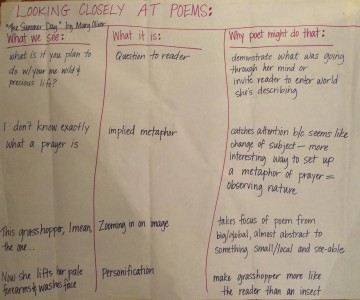As with other genre studies, we devote 3-5 days to “reading like a writer,” noticing craft strategies in a few touchstone texts and trying these strategies with our own works-in-progress.
In this stage, we begin to study published poems more closely, looking at the ways in which the poems are assembled, or crafted. We choose a few touchstone texts and dissect them, noticing the intentional decisions that the poets made and their overall impact on the final poem.
Pictured below is a noticing chart created by one class while looking closely at “The Summer Day” by Mary Oliver (the text of the poem is also attached in the files at the end of this page). When we read like writers, we not only notice the exact words of the text but also try to name what it is the poet is doing and hypothesize why the poet chose to write the poem in this way. This helps us become more discriminant in choosing craft strategies for our own texts.

As you become more familiar with the poetry unit and its lessons, you may notice that several of the mini-lessons can work in more than one place in the unit. For example, a lesson on line breaks and white space could appear during the craft phase (before drafting) or during the revision phase (after drafting). In this module, we have placed the line breaks lesson in both places to remind you that you can choose where this lesson best fits in your classroom. This may be true of other lessons as well, because many good revision lessons are actually based on craft observations.
Teacher Try-It:
Repetition. Study the poems in the touchstone packet below, paying particular attention to how these poets used repetition. Then choose a line or phrase from one of your poems-in-progress and experiment with different ways and patterns of repeating it.
Previous ChapterGathering & Nurturing Ideas Next Resource
Drafting


